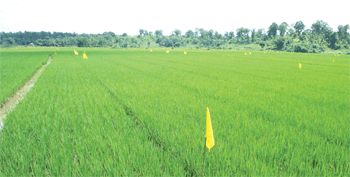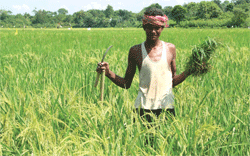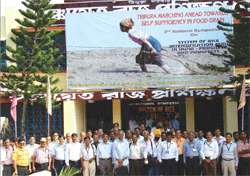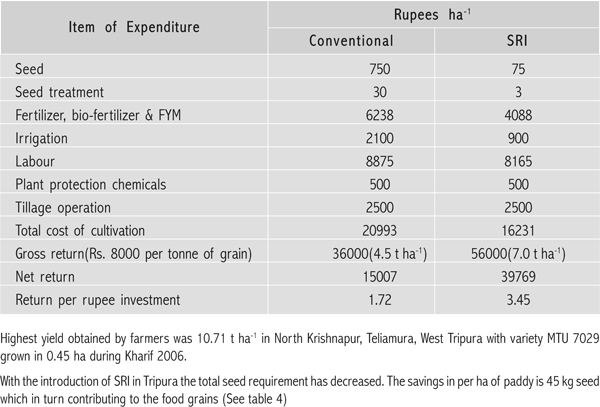| |
|
 Background Background
Rice is the principle crop of the state covering 78 per cent of cultivable area. Paddy area has almost remained stable at 0.25 million ha. Paddy production during the last decade fluctuated between .74 to .93 million tonnes and the paddy productivity ranged from 2.9 to 3.7 t ha-1. Food security strictly depends on rice production as no other cereals are grown by the farmers in the state due to food habits and agro-climatic situations. Selfsufficiency in food grains can be attained
only through enhanced productivity of rice in the coming days. On the other hand due to demographic pressure and shrinkage in the cultivable area, especially rice, the state Department of Agriculture has started to promote SRI method of rice cultivation to attain self sufficiency in food grains. Evaluation of SRI was initiated in the boro season of 1999-2000 at State Agriculture Research Station of the Depar tment of Agriculture. Adaptability under different agro-climatic conditions of Tripura was studied from 1999- 2002 for five seasons covering\ both aman and boro seasons . The yield obtained in the first year trial was poor but from the third season there was positive response with better understanding of the principles.
 The Department of Agriculture star ted SRI demonstrations in 2002-03 and the number increased from 44 to 1,62,485 in 2007-08. Large-scale adoption star ted through demonstration in the farmers’ field (0.2 ha) with the cultivation incentive of Rs. 4,000 per ha. The Department of Agriculture star ted SRI demonstrations in 2002-03 and the number increased from 44 to 1,62,485 in 2007-08. Large-scale adoption star ted through demonstration in the farmers’ field (0.2 ha) with the cultivation incentive of Rs. 4,000 per ha.
SRI is promoted under the State Plan and the Government of India’s (GoI) Macro Management Scheme. Research was conducted solely under the State Plan and popularization/ adoption in fields were done through convergence of State Plan
and the Macro Management Scheme of GoI. The Panchayat Raj Institute is collaborating in the demonstrations across the
state. Agriculture assistants/village-level workers posted in every village of Tripura are responsible for dissemination and
adoption of any new technology on fields.
Local newspapers have played a very significant and positive role through spreading information about the yield advantage
of SRI over conventional practice and through interviews of farmers practicing SRI.
 Experimental demonstrations conducted on the farmers’ fields, in the initial years, were personally visited by Honorable Experimental demonstrations conducted on the farmers’ fields, in the initial years, were personally visited by Honorable
Chief Minister, Agriculture Minister, other Ministers, Chief Secretary, and many other dignitaries and high officials of the
state interacted with the farmers. Public Accounts Committee (PAC), Tripura Legislative Assembly also visited the SRI plots
and interacted with the farmers.
Training programme were conducted locally for all categories of field functionaries. All officers having basic qualification in
agriculture were trained in the year 2003-04. District level trainer s team was developed through rigorous on-farm practical and theoretical training and they imparted training to grassroot-level field level staff. |
| |
Performance
The differences in the yield attributes of the conventional and SRI crop observed in farmers’ fields are presented in the
table 1. |
| Table 1 : Yield attributes in conventional and SRI crops. |
 |
| |
| Table 2 : Grain yield of varieties, hybrids and land races in Tripura (t ha-1) |
 |
| |
| Table 3 : Economics of SRI Cultivation in Tripura (Average over obser vations from several farmers) |
 |
| |
Highest yield obtained by farmers was 10.71 t ha-1 in North Krishnapur, Teliamura, West Tripura with variety MTU 7029 grown in 0.45 ha during Kharif 2006.
With the introduction of SRI in Tripura the total seed requirement has decreased. The savings in per ha of paddy is 45 kg seed which in turn contributing to the food grains (See table 4) |
| |
| Table 4 : Year-wise savings of seed quantity in Tripura due to adoption of SRI |
 |
| |
Experiences in Adoption
In Tripura all sections of society are practicing SRI. Women farmers of tribal and Manipuri community are frontrunners, and their farm activities and crop management is excellent.
Farmers have difficulties in adopting all the SRI principles due to a mindset or in other words due to traditional habits. Sometimes a fear psychosis also prevents switching over to a new system. Farmers who have practiced the SRI for two to three seasons could easily overcome the difficulties. |
| |
Way Forward
Tripura launched a “Perspective Plan for Self-Sufficiency in Food grains by 2010” in the year 2001. During the mid-term review it was observed that the growth rate of the food production is not at desired level. Hence Department of Agriculture has reviewed the strategy. Rice being the basic growth engine of the state agriculture as well as economy it was decided to increase the production and productivity by adoption and popularization of SRI to cover at least one lakh ha paddy area which will increase minimum one lakh tonnes of rice than the present production level in the year 2011-2012 (see Table 5). |
| |
| Table 5 :Projected increase in food grains production (lakh tonnes) due to SRI |
 |
| |